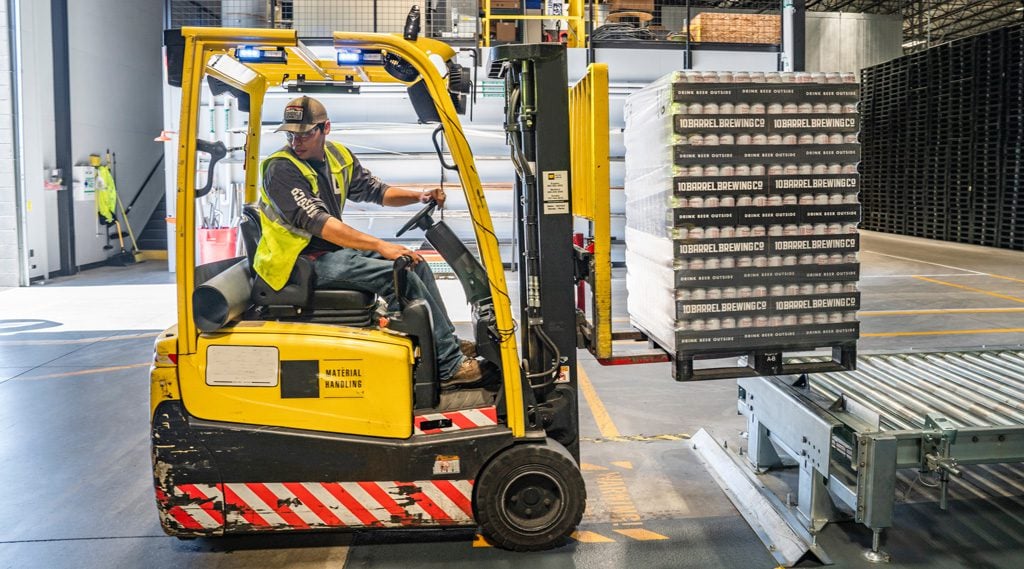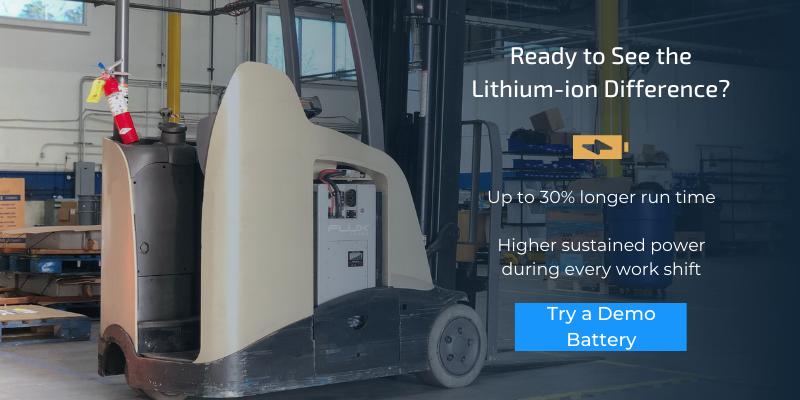How Much Does a Forklift Battery Cost You?
Many people erroneously believe that the purchase price of a battery is the largest cost they will incur from ownership. In reality, the total cost of ownership goes much deeper than that. Different types of forklift batteries vary in price.
In general, the purchase price of a lead acid battery is much lower than the price of a comparable lithium-ion battery pack. Sure, the cheapest battery option might seem like the most cost-effective choice initially. But knowledgeable and wise warehouse managers understand that they need to look at the big picture in closer detail to understand the true costs.
The True Cost of Lead Acid Batteries
From labor to maintenance, there are hidden costs associated with lead acid batteries that may be more than just a nuisance.
Hidden costs come in the forms of:
- Time: Lead acid batteries can only be used for 8 hours, with 16 hours of charging and cool-down time.
- Labor: More labor is needed for lead acid batteries due to all the maintenance requirements they have.
- Safety: Lead acid batteries need special charging rooms because of the chemicals and gasses they produce.
- ROI: Since lithium-ion is more energy efficient, the reduction in energy costs can be substantial compared to lead acid.
Here are some hidden costs you should know about before you commit to lead acid forklift batteries for your entire fleet.
Lifespan
Lead acid batteries might be cheaper to purchase initially, but you will be replacing them more often.
The main differences you will see when purchasing a lead acid battery versus a lithium-ion battery pack is the shorter cycle life lead acid batteries have. Lead acid batteries usually have a cycle life of 1,000 to 1,500 cycles if maintained correctly.
On the other hand, lithium-ion batteries usually have a cycle life of 2,500 to 3,000 cycles. This means you will be replacing your old lead acid forklift batteries twice as often as lithium-ion batteries - and that doesn’t even account for how much shorter the lead acid battery lifespan could be if operators do not take care of the battery!
A few key factors that could contribute to a shortened lifespan for lead acid batteries include opportunity charging and overfilling water levels.
Opportunity charging: Lead acid batteries are not meant to be opportunity charged or fast charged like lithium-ion batteries. If you opportunity charge a lead acid battery, this could lead to sulfation. Sulfation is when sulfur forms on the lead plates which decreases battery performance as well as lifespan.
Overfilling water levels: Overfilling water levels in a lead acid battery could cause electrolyte loss and corrosion of the battery. This causes the battery to unevenly charge, therefore shortening the lifespan of the battery.
Forklift Battery Maintenance
Lead acid batteries are not closed systems. Instead, they require periodic maintenance.
Lead acid maintenance requirements can include:
- Watering
- Cool down periods
- Checking ventilation holes
Watering: You must water lead acid batteries after charging to replenish electrolyte levels. The tricky part about replenishing these batteries is that it is possible to overwater or underwater the batteries. Both overwatering and underwatering can cause significant damage to the battery’s lifespan.
Cool down periods: After fully charging a lead acid battery, it requires an 8-hour cool-down period because the battery can get extremely hot. If the battery is used immediately after charging, instead of cooling down, the lead acid battery can heat up too much, damaging the battery.
Checking ventilation holes: Forgetting to check ventilation holes is an easy to forget maintenance mistake. Ventilation holes allow gas to escape and if it cannot escape, pressure is built up. If the pressure gets too high, it can cause an explosion resulting in safety concerns for the operator and others in the facility.
In contrast, lithium-ion batteries are virtually maintenance free, so they:
- Can’t be overcharged
- Don’t require watering
- Don’t require cooldown periods
Operational Efficiencies
You may not realize just how much lead acid batteries can impact your operational efficiencies in terms of uptime, but lead acid batteries might be the one thing that are holding your operations back from scaling your warehouse efficiency to the next level.
Lithium-ion batteries can run for longer before needing to be charged, take less time to charge, and can be charged at your convenience (i.e., operator breaks). If you are trying to improve efficiencies, eliminating the extra step of trying to charge a lead acid battery is a big bonus.
To charge a lead acid battery, the operator must use special equipment to remove the battery and transport it to the charging station only to take a second lead acid battery that is charged and install it into the waiting forklift. Though it might only take 15 to 20 minutes, this is non-productive time that is repeatedly lost ever charging cycle.
If you want an efficient warehouse, lithium-ion batteries might be the solution since the battery packs do not need to be removed from the forklift for charging. That extra 15 to 20 minutes could be reclaimed for productive use to meet operational goals.
Labor
Accurately tracking labor costs can be tricky, especially when you are talking about minutes spent here and there on certain tasks. The labor costs associated with lead acid batteries are often overlooked for this reason. The time spent to maintain and operate forklifts with lead acid batteries should not be underestimated. Shorter run times means you will be spending more time swapping out batteries or equipment downtime for charging.
Plus, additional travel time to and from the battery charging room. You will spend labor on maintaining the batteries through:
- Watering
- Equalizing charges
- Cooldown periods
Lithium-ion batteries help you eliminate all the unnecessary labor costs associated with lead acid batteries because they are essentially a maintenance free forklift battery pack. The battery management system (BMS) integrated in a lithium-ion battery pack helps to keep temperatures under control and automatically balance the cells when needed. This minimizes extra labor costs.
Safety
Lead acid batteries are more labor-intensive than lithium-ion batteries. Not only do they present more health and environmental hazards, because of watering and off-gassing, but they also create more ergonomic hazards. One of the most taught things in material handling is forklift safety. Within forklift safety training, handling the batteries that are used with the equipment is crucial, especially with lead acid batteries. Because of their maintenance and chemical hazards, they can produce, training is implemented to ensure workers are safe in certain situations that involve handling batteries.
Dedicated Space
When it comes to getting maximum ROI out of your operations, warehouse space is something to consider. Improving the physical flow and storage space of your warehouse is essential to saving time and money. That is why lead acid batteries might be costing you more than you think.
They require large, ventilated, and isolated charging/changing/maintenance rooms. These rooms are made to release lead acid battery gas cause by the heat from charging. Having a ventilated changing room is one requirement that is a must when purchasing lead acid batteries.
Lithium-ion batteries can help make your operations more cost-effective by eliminating the need for a dedicated battery room. The extra charging space can be reclaimed for your operations.
Improve Your ROI & Avoid Hidden Costs by Switching to Lithium-Ion Forklift Batteries
Many people think that a forklift battery’s purchase price is all they will need to consider. But this simply is not true. There are many other “hidden” costs associated with lead acid batteries that often get overlooked.
- Time (i.e., efficiencies)
- Labor
- Safety
- ROI
Fortunately, there is an easy way to avoid losing money to these hidden costs - make the transition to lithium-ion batteries. Lithium-ion batteries can help reduce those maintenance costs and safety concerns that are attributed to lead acid batteries, all while helping you create efficiency gains and a return on your investment.












